|
|
File
National Archaeological Museum of Altino – Quarto d’Altino
|
Via Sant’Eliodoro 37 – Altino – 30020 Quarto d’Altino (VE)
– Fax 0422 829008 |
  |
|
Summary
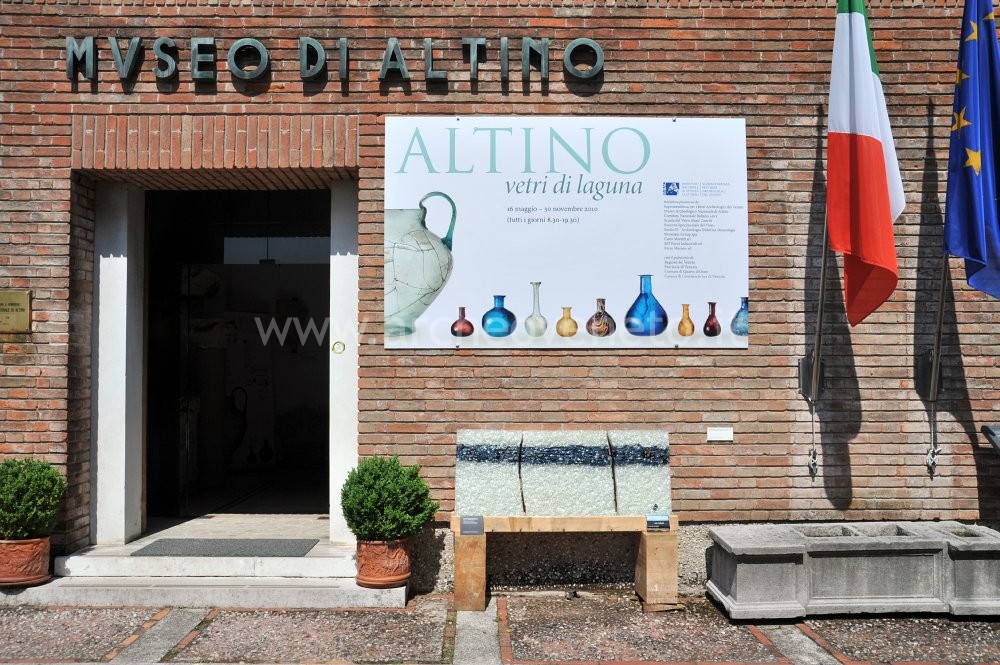
The Museum is situated within the archaeological area of Altino. The exhibition is presented in rooms 1 and 2 , along the portico around the square in the middle and in the garden in front of the Museum. The exhibition ‘Altino. Lagoon Glass’ is presented in six displays located in these two rooms. Renovation works of the new premises are well underway and soon an additional section will open in a rural complex located nearby. It will host a much larger collection of prehistoric, Roman and Late Antiquity-Early Middle Age exhibits.
Collection history
From around 1880s scientists and Veneto institutions started to take interest in the topography of the ancient Altino and in the archaeological items of Altino origin belonging to Reali family, then owners of the area. More objects from the city and its necropolises were found as a result of excavation, agriculture and reclaim works. The need for proper preservation of such numerous and important findings became evident and urgent. Eventually, under the management of Bruna Forlati Tamaro, the National Archaeological Museum of Altino was opened in 1960. In spite of space limitations there have been regular re-arrangements of the exhibition since then. The current exhibition was set up under the title of ‘Altino. Lagoon Glass’ in 2010 as a permanent arrangement.
|

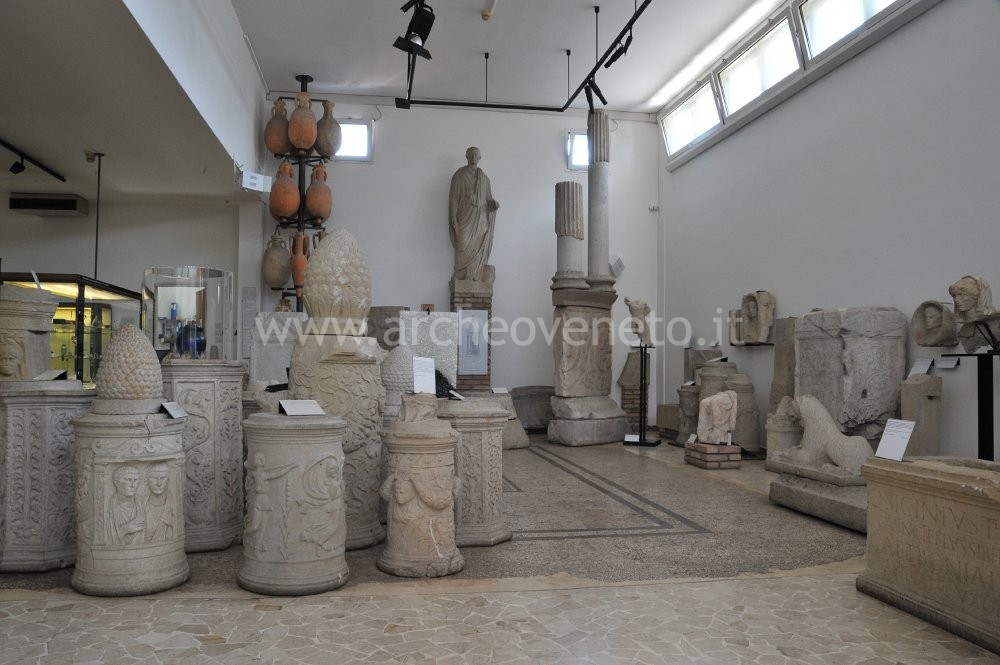 This room comprises exclusively funeral monuments from Altino necropolises: This room comprises exclusively funeral monuments from Altino necropolises:
– large monuments, e.g. baldachin-shaped mausoleum, partly renovated, located at the bottom of the room
– round and octagonal altars that used to contain burned bones and were used as covers for box-shaped urns
– stele or pseudo-constructions at the top of the grave with one or more portrays and with an inscription stating the name of the deceased and who the monument was erected by.
Scattered around the room are various decorative elements found in necropolises, e.g. a headless statue of Icarus.
There is a series of capitals and a fragment of a cornice from the urban area on the left from the entrance and sundials from the necropolises and living areas in front of the entrance. Around the same area there is an altar dedicated to Benere and other four small altars dedicated to local cults: Lucra Merita (Guadagni Meritati), Vetlonia (Vetulonia) and Di Inferi (divinity dell’Oltretomba). On the floor there are two mosaics in black and white, one in front of the entrance and the other in the middle of the room, dated between the end of 1st century and the beginning of the 2nd century AD and 1st century AD respectively.
Also in this room there are two ‘trees’ used for amphoras presentation, found during excavations of the urban districts and necropolises.
The permanent exhibition ‘Altino. Lagoon glass’ is presented in 4 display cabinets:
Display 1: at the front there are some extraordinary exhibits which demonstrate the techniques used for mosaics production and hot worked ‘Murrino’ glass (top shelf), Murrino glass tapes (middle shelf) and melted glass (bottom shelf). At the back of the display on the top shelf there are some items made using the ‘smelting mould’ technique and a range of cups with ribbed decorations. On the middle shelf there are plaques and murrinos with miniature decorations whereas on the bottom shelf there are some pieces of jewellery and a golden plate.
Display 2 holds artefacts produced using various techniques: (top shelf) mould-blowing technique (top shelf), the technique of ‘applied splinters’ (middle shelf) and the technique of applied blobs and applied broken threads (bottom shelf). At the back of the display there are some examples of mould-blown bottles and a range of balm containers in horn (top shelf), cups with ribbed decorations, brooches (middle shelf) and items in grinding and engraving techniques (bottom shelf).
Display 3: on the top and middle shelf there is a range of bowls in various sizes and glassed amphoras used in necropolises as prestigious ossuaries and realised using the free blowing technique; on the bottom shelf there are fragments of glass cotisso and other items such as various kinds of bottles and urn covers.
Display 4: all the shelves present a range of differently shaped objects created using the free blowing technique: balm containers, bowls, cups, small amphoras, brooches, plates, one skyphos and one aryballos, etc.
|

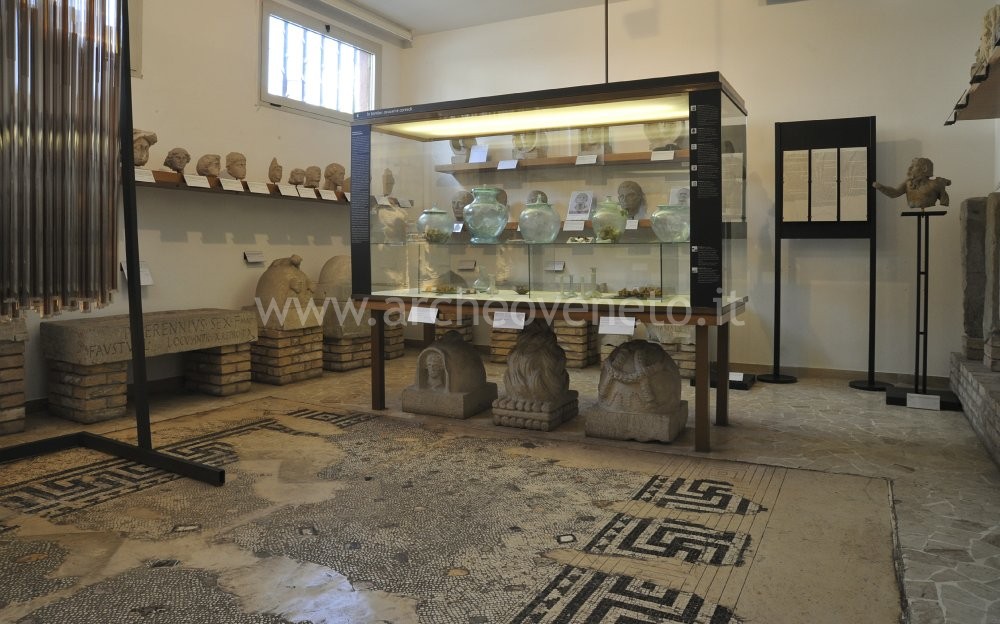 Also in this room there are mainly funeral monuments from Altino necropolises, dated mostly from the 1st century AD. Also in this room there are mainly funeral monuments from Altino necropolises, dated mostly from the 1st century AD.
Along the walls on the entrance side there is a series of engraved funeral stele, used mostly to fence off the grave area. The engravings usually state the name of the deceased, who the monument was erected by and the dimensions of the front and the sides of the fencing. The sphinx, dogs and lions presented on the shelves on the left were originally placed on the top of the stele or at the corners of the grave fencing and were meant to protect the tomb. On the shelf on the right there are antefixes (among others the one representing Potnia theron), and acroteria, which used to decorate the roofs of the tombs and buildings.
On the wall on the far left there are two powerful statues of the Giants (both headless), which used to crown the tomb monument of south-west necropolis of Annia, one partly dressed statue of a woman and a part of Dionysus statue, both in marble.
On the wall on the far right there is a limestone torso of a sea divinity and a part of Silenus statue in marble. On the two shelves at the bottom of the room there are some portrays which used to be part of either funeral statues or the clipeus.
Along the wall in front of the entrance some of the pseudo-construction funeral stele associated with the box-shape urns are presented. On the shelf on the left there are pieces of friezes which used to decorate the tomb monuments and two decoration elements from one of the city gardens. On the shelf on the right you will find a series of head portrays from the funeral monuments or stele, and a large portray of a woman from the Flavian Age.
Along the walls and below the display cabinets there is a series of ossuaries and their decorative covers: typical for the Altino region are cover decorations in a semi sphere shape, set on a plinth and with an engraving that then carried on further onto the urn.
On the floor there are two black and white mosaics, one in the centre of the room dated from the first half of the 1st century AD and a smaller one located in front of the two Giant statues and dated from the end of the 1st and beginning of the 2nd century AD.
Two display cabinets present a series of glassed ossuaries and their grave goods. They were discovered during the excavations in the Altino necropolises and they are also part of the ‘Altino. Lagoon glass’ exhibition. The contents of the grave goods and the way they are deposited illustrate the ancient funeral rituals.
|

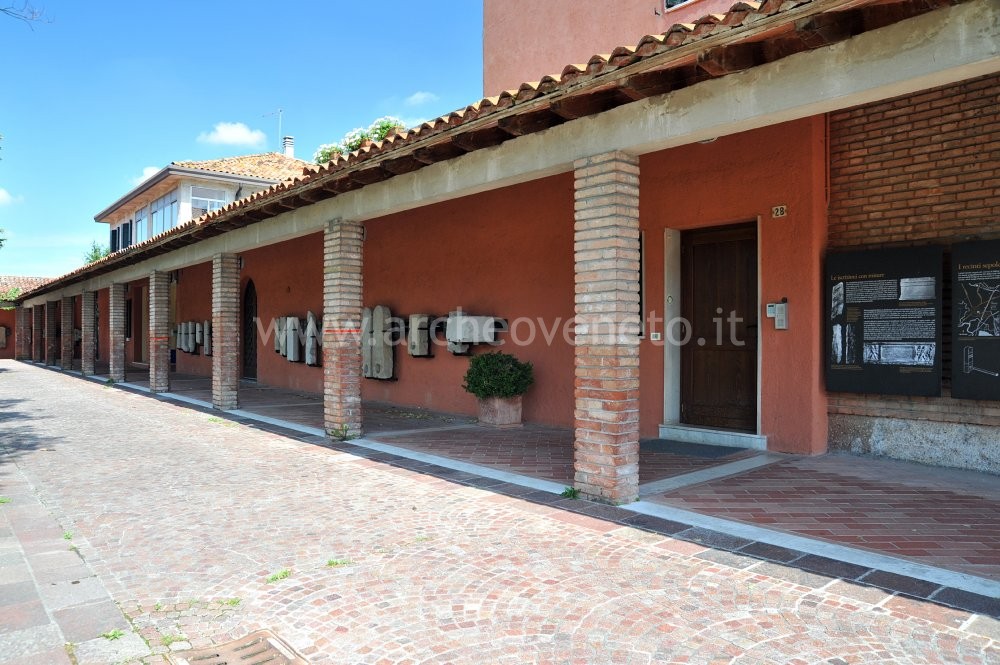 The tour starts from the side of the portico which surrounds the Museum. There are three themes covering the following subjects: the composition and function of the Roman grave fencing, their location in Altino region and the meaning of the engravings. The exhibition presents around forty stone monuments from the pre-Imperial Age (1st century BC – 2nd century AD). These monuments provide information on the size and ownership of the tomb fencings discovered in Altino necropolises in via Annia, via per Oderzo and another street that used to join the other two. On the opposite wall there is a squared oak trunk found in Sioncello canal area and probably used to reinforce the shore. At the end of the tour there is a panel that perfectly illustrates the archaeological area of Altino. The tour starts from the side of the portico which surrounds the Museum. There are three themes covering the following subjects: the composition and function of the Roman grave fencing, their location in Altino region and the meaning of the engravings. The exhibition presents around forty stone monuments from the pre-Imperial Age (1st century BC – 2nd century AD). These monuments provide information on the size and ownership of the tomb fencings discovered in Altino necropolises in via Annia, via per Oderzo and another street that used to join the other two. On the opposite wall there is a squared oak trunk found in Sioncello canal area and probably used to reinforce the shore. At the end of the tour there is a panel that perfectly illustrates the archaeological area of Altino.
|

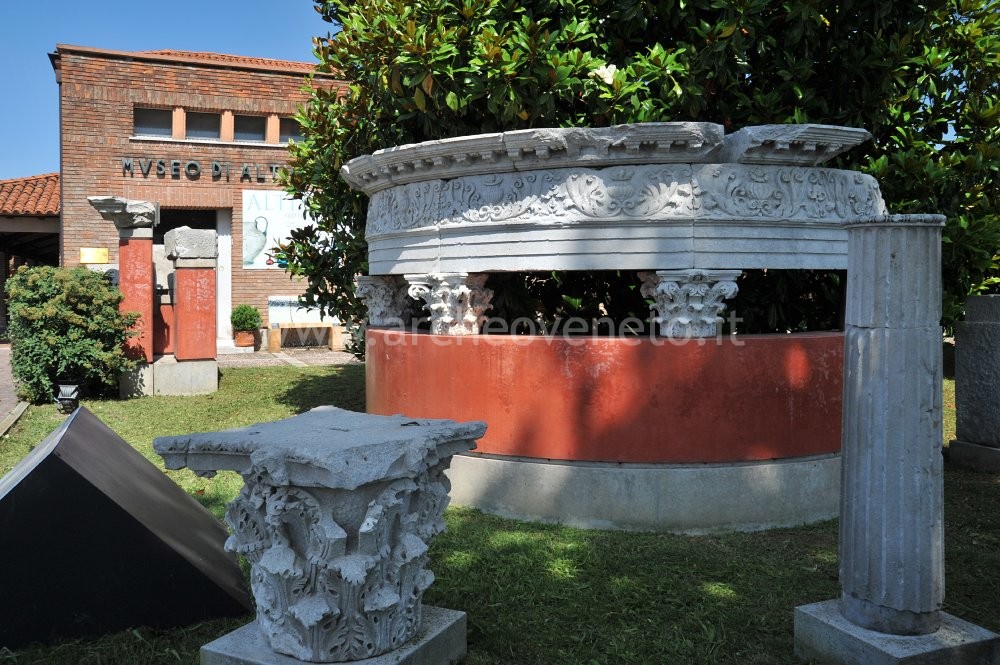 In front of the Museum entrance there is a fragment of an architrave that used to be part of the ‘coronamento’ of the baldachin-shaped mausoleum (portrays from this monument presented in Room 1). In front of the Museum entrance there is a fragment of an architrave that used to be part of the ‘coronamento’ of the baldachin-shaped mausoleum (portrays from this monument presented in Room 1).
Among various findings placed along the façade and in the garden there are parts of notable architraves and decorative cornices.
In the small garden there is a reconstruction of a trachyte tomb fencing. The monument comes from the necropolises found in the Northeast part of Annia. Also in the garden you can find a part of the road exposed in the eastern archaeological area.
|
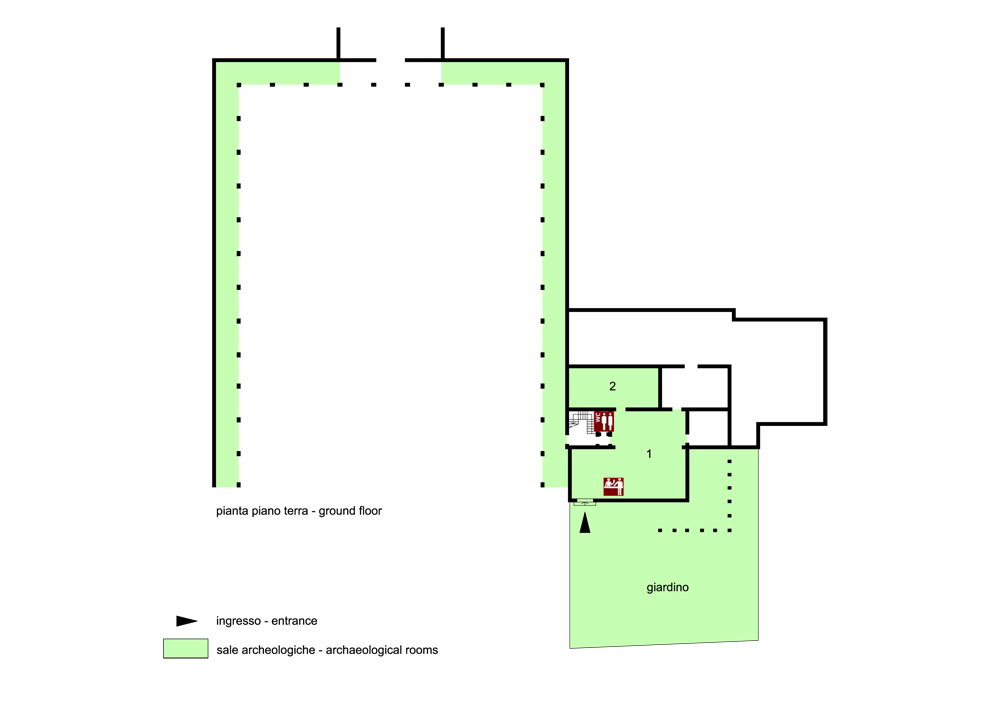
Admission: Negli orari di apertura
Ticket: Si
Price: Full price € 3; reduced € 1,5 (between the age of 18-25); free entrance for EU citizens under 18 and over 65
 School access School access
Preferably upon booking
 Disabled access Disabled access
Opening Days
| Tipology |
When |
Specs |
| Summer/Winter |
Monday |
08.30-19.30 |
| Summer/Winter |
Tuesday |
08.30-19.30 |
| Summer/Winter |
Wednesday |
08.30-19.30 |
| Summer/Winter |
Thursday |
08.30-19.30 |
| Summer/Winter |
Friday |
08.30-19.30 |
| Summer/Winter |
Saturday |
08.30-19.30 |
| Summer/Winter |
Sunday |
08.30-19.30 |
Closed on the 25 December, 1 January and 1 May. The ticket office closes at 7pm.
Nel museo è attualmente allestita la mostra "Vetro Murrino da Altino a Murano", aperta dal 16 giugno 2012 al 6 gennaio 2013.
Recommended tour time (minutes): 120
 Toilet Toilet
No disabled facilities
 Parking Parking
Commune parking with limited space around portico
 Guide a stampa Guide a stampa
Audio guide
Brochure
Audio guides and Braille guides are available.
 Information boards Information boards
 Captions under exhibits Captions under exhibits
 Multilingual ads: Inglese Multilingual ads: Inglese
Tedesco
 Guided Tours Guided Tours
Booking required, organised by Synthesis: tel. 041 5311460, 041 5310368; e-mail: segreteria@synthesis.ve.it
 Educational activities Educational activities
Booking required, organised by Studio D: tel. 049 8360553, 348 2858309; e-mail: info@studiodarcheologia.it
 Educational workshops Educational workshops
Booking required, organised by Studio D: tel. 049 8360553, 348 2858309; e-mail: info@studiodarcheologia.it
 Library and documentation centre Library and documentation centre
The library and the archive are on the first floor; access is restricted to Museum staff and authorised scholars.
| Sena Chiesa G. 1960, Le stele funerarie a ritratti di Altino, in Memorie dell’Istituto Veneto di Scienze, Lettere e Arti, XXXIII, pp. 3-77. |
| Tirelli M. 1991, Altino. Il Museo Archeologico di Altino, in La Terraferma veneziana, Venezia, pp. 49-63, 892-906. |
| Tirelli M. 1993, Il Museo Archeologico Nazionale e le aree archeologiche di Altino, Padova. |
| Musei e raccolte archeologiche del Veneto 2004, a cura di Di Mauro A., Dosson di Casier, pp. 100-101. |
| Bonetto J. 2009, Veneto (Archeologia delle Regioni d’Italia), Roma, pp. 441-443. |
| Altino. Vetri di Laguna 2010, a cura di Barovier Mentasti R., Tirelli M.. |
|

